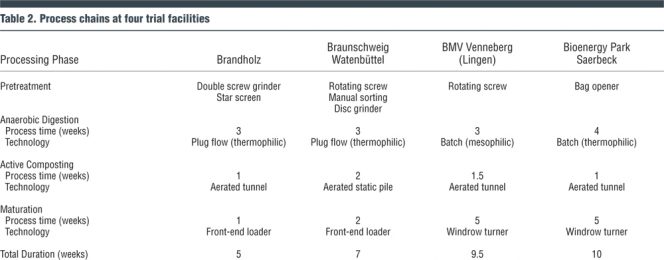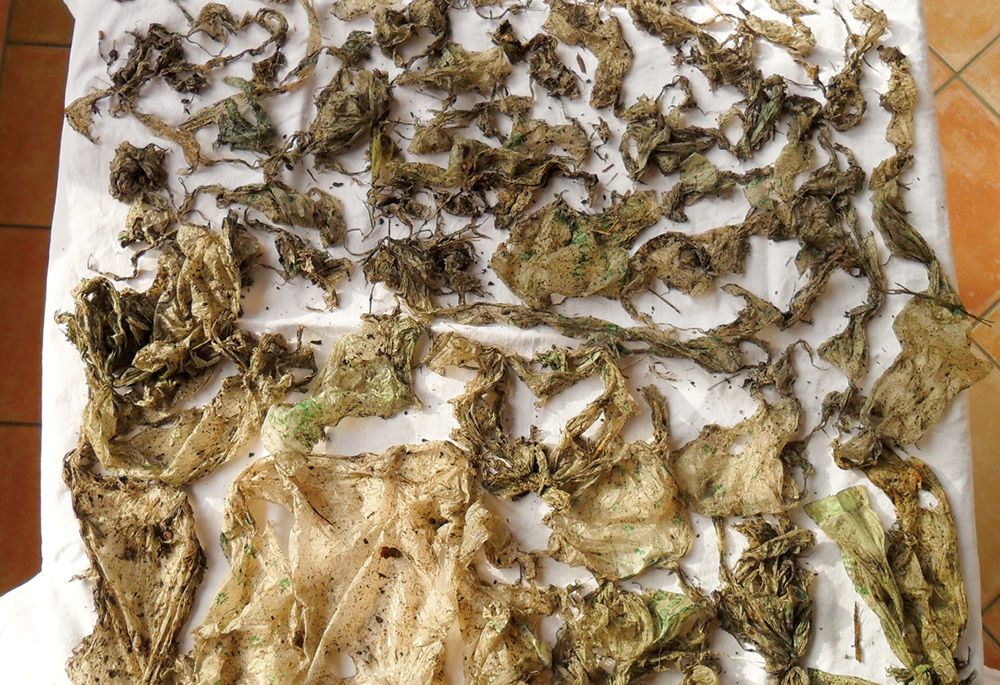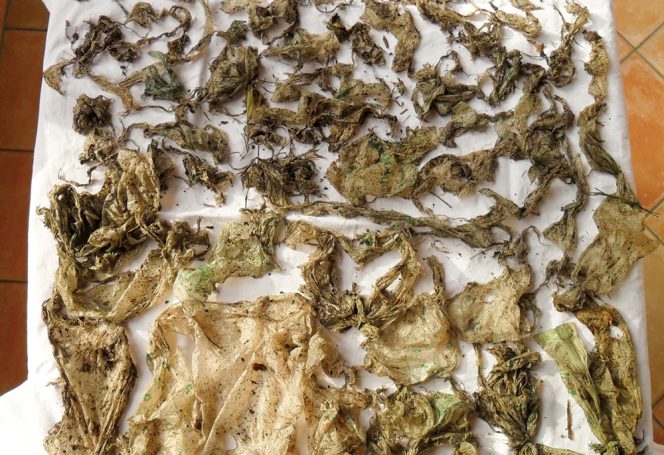Certified biodegradable and compostable bags containing municipal biowaste were processed at four German facilities with AD and composting systems.
M. Kern, T. Turk, A. Hüttner and U. Koj
BioCycle September 2018
Increased use of anaerobic digestion in Germany to produce energy from municipal organic waste has raised many waste management authorities’ interest in higher captures of food scraps — due to their potentially high biogas yields — from householders’ kitchens in their municipal waste collection schemes. Even in areas with existing organic waste collection, waste analyses are repeatedly confirming that a significant proportion of these energy-rich renewable raw materials are still remaining in the residual waste and incinerated, an end of life option which does not make much sense for a waste fraction made of more than 70 percent water.
To facilitate collection of residential organics (particularly food scraps), compostable and biodegradable plastic bags are already being used in many municipalities. (Compostable plastic bags are defined in this article as items made of compostable materials that are offered explicitly for collection of organics, and whose biodegradability and compostability have been tested according to the standards DIN EN 134342 and/or DIN EN 14995.) Nevertheless, some German organic waste processors still have doubts about use of compostable plastic bags. This is particularly the case for plant operators exclusively composting biowaste. Their primary concern is the potential for an increased amount of noncompostable plastics entering their systems and to the possibility of compostable bags not completely degrading during short composting periods.
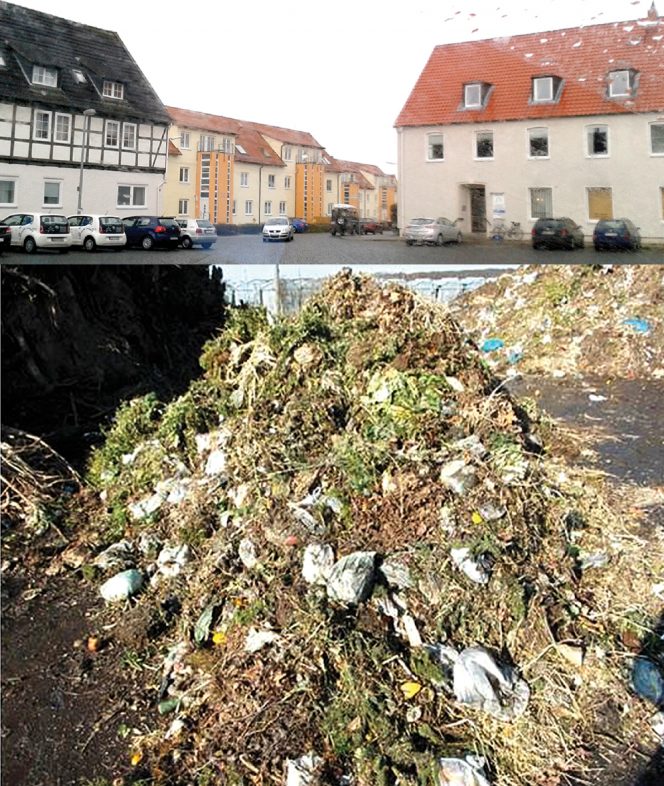
In the town of Braunschweig (top), source separated biowaste placed in certified compostable bags, along with loose garden waste (above), were collected from households for the field trials.
Furthermore, some recently built AD plants have limited capacity and to keep up with the annual inflow of municipal organics, have further shortened their processing times, making the treatment of compostable bags more challenging. Finally, there is concern among decision-makers that the endorsement of compostable bags could lead to additional use of noncompostable polyethylene bags.
Field Trials
Against this background, IGLux Witzenhausen GmbH and Witzenhausen-Institut GmbH were commissioned by Novamont SpA (manufacturer of the compostable resin Mater-Bi®) to conduct an investigation and evaluation of the degradation behavior of compostable plastic bags during comprehensive field trials in four different AD and composting facilities in Germany. The aim was to investigate how material flow management and processing, and AD technology with downstream composting, are affecting the degradation behavior of compostable plastic bags along the entire process chain. The pretreatment technologies utilized at the facilities also influenced how the compostable plastic bags were directed into the various material streams. Each of these streams was individually monitored, analyzed and evaluated.
Prior to this study, field trials conducted to investigate the degradation behavior of compostable plastic bags in Germany had almost exclusively considered composting plants only. Integrated systems, i.e., composting with upstream anaerobic digestion, had not been scientifically investigated.
The field trials were carried out in two discontinuous processes (dry batch processes known in the U.S. as, high solids AD (HSAD)) and two continuous processes (plug flow processes). The technologies and preprocessing equipment used by these four plants cover a large proportion of existing German facilities treating municipal organics. The trials were carried out from April 2016 to October 2016. The four anaerobic digestion and composting facilities involved in the trials are listed in Table 1.
For each plant the specific pretreatment and the anaerobic digestion phase as well as the subsequent active composting and maturation stages were investigated. The percentage of compostable plastics in the input was determined to be between 3.5 and 3.8 percent by weight.
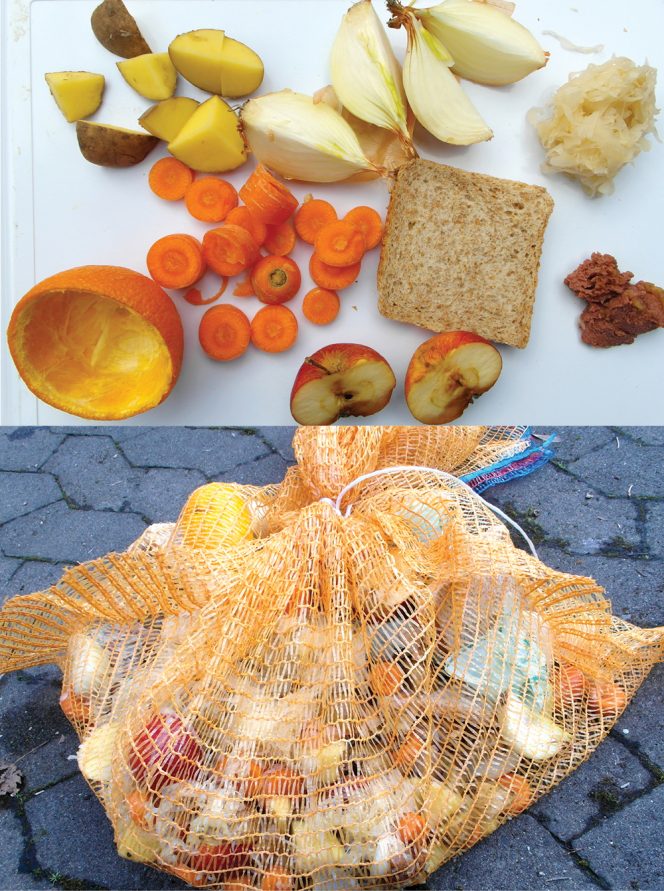
Researchers prepared standard reference samples to evaluate the possible influence of the collected biowaste composition on the degradation rate of the compostable plastic bags. The food scraps (top) were coarsely size reduced then placed with 3 compostable bags inside a net (bottom).
Sample Material And Testing
For each of the four facilities i.e. for each of the four processing configurations, between 2 and 4 metric tons of collected organics were used (about 50% of the organics were contained in Mater-Bi® bags while the rest was loose garden waste). The sample material was mixed to be as homogeneous as possible.
For all trials, municipal organics collected from households in the town of Braunschweig were used. In cooperation with ALBA Braunschweig GmbH, a test neighborhood was selected in the southern part of the town where a ventilated kitchen container and a sufficient number of Novamont compostable bags were distributed for free to 1,500 households. The neighborhood consisted primarily of single family houses and terraced houses. The quality of the collected organics in the test area was determined by specific waste analyses.
Sample material was transported to the four facilities and fed into the standard processing chain of each plant. The Brandholz facility size-reduced the material using a two-shaft shredder and a star-screen sieving process; the oversized fraction — ranging between 15 and 20 percent of incoming feedstock — was sent to a combustion plant with energy recovery. About 30 percent of the compostable plastic bag fragments were also separated with the oversized fraction.
At the Braunschweig facility, the sample material was precrushed by a screw mill, and screened; the fine fraction was fed directly into the digester. The oversized fraction went through secondary high speed shredding, then was fed into the digester. At the two batch plants, the complete material load was put into the digester after bag opening or shredding.
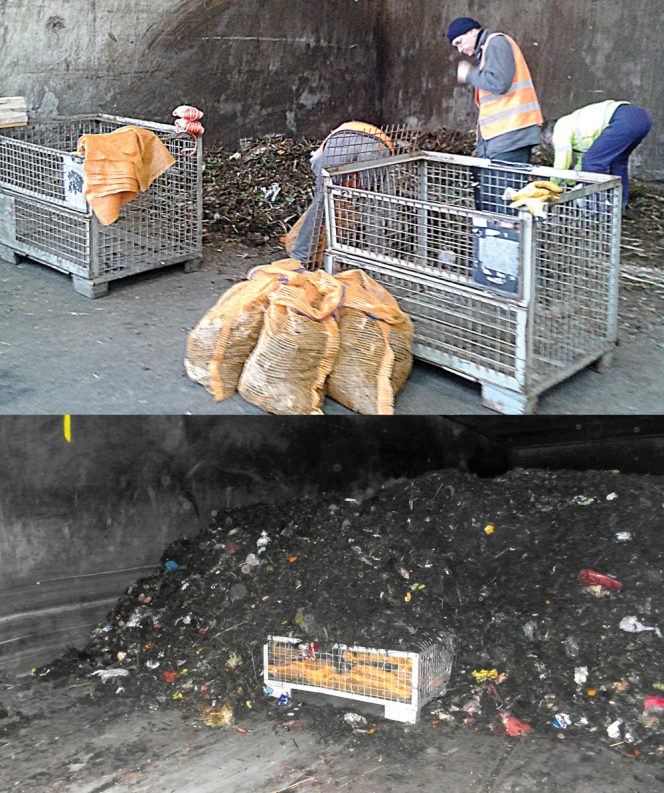
All samples were placed in cage boxes and put in the digesters for the entire anaerobic phase (example at a batch digester shown).
About 20 onion net bags were filled with about 20 liters (5.3 gallons) of organics each. The reference samples also were put in onion net bags. All bags were placed in cage boxes and put in the digesters for the entire anaerobic phase. In the case of plug flow systems, the net bags could not be safely put in the digester without the risk of losing them. This issue was solved by putting these samples in the thermophilic batch digester at the Saerbeck plant instead and then returning them for the aerobic treatment stages following the digestion stage of the original plug flow plants (i.e. active composting and maturation).
Apart from the technical exception described above, all the samples remained embedded in the entire process chain of the selected plants. All mechanical processing, e.g. transfer operations and input or extraction procedures were simulated for the embedded sample material.
The progress of the degradation of the compostable plastic bags was documented by extracting and analyzing samples during these three phases of the process:
• After the anaerobic phase (digestion)
• Aerobic phase after active composting
• Aerobic phase after maturation
The analyses of the compost after it was finished and ready to be used in agriculture were of particular importance, due to compliance with the RAL quality mark criteria and the German fertilizer regulation. The compost samples were analyzed by a certified laboratory with regard to the following test parameters:
• Visual assessment and photo documentation
• Foreign substance content according to the RAL quality mark criteria
• Total surface area of compostable plastic residues per litre of compost
• Water content
• Organic dry matter content
• Compost stability (Rottegrad)
Table 2 summarizes the process chain at the four facilities, showing the duration of the individual process steps. Total treatment time (anaerobic phase plus aerobic phases) ranged between five and ten weeks. The retention time obviously has a significant impact on the extent of degradation of the compostable plastic bags. The longer the retention time, the more likely the complete degradation of the compostable plastic material should occur. The processing and pretreatment technology would also have a significant influence on the speed of degradation.
In addition to the different pretreatment methods (e.g., shredding, crushing, screening), the different AD systems (continuous and discontinuous) need to be acknowledged because in the trial, the continuous plug flow AD phases were replaced by the thermophilic batch AD phase at the Saerbeck plant. In addition, the composting phases differed significantly in all four systems (Table 2). The residence time in the enclosed active composting phase following AD ranged between one and two weeks. The subsequent compost maturation phase was mostly covered by a roof (open only at the Watenbüttel facility); the turning process was managed by front-end loaders at two plants and compost turning machines at the other two. The final compost maturation phase ranged between one and five weeks.

Figure 1. Sampling process and degradation steps in facility 3, Lingen. (Photo on left: washed compostable plastic bag fragments)
Results
Figure 1 shows the entire process chain and the phases/retention times when the samples were taken. The Lingen plant is used as an example. The compostable plastic bags contained in the samples were photographed. After the aerobic stabilization stage (see photo on the right, Fig. 1), no more compostable plastic residues were found.
Table 3 shows the total degradation results in the four plants. On average, the proportion of compostable plastic in the input material was between 3.5 and 3.8 percent by weight. The partial degradation of the compostable plastic bags demonstrated in the anaerobic phase could not be further verified. The fact that the value in the Lingen plant even rose after anaerobic digestion is due partly to the fluctuation of the compostable contents in each sample and partly to the feedstock total mass reduction caused by its conversion to biogas.
After the active composting stage a further reduction in the compostable plastic proportion was determined. Intensive preshredding (e.g. in Braunschweig), as well as intensive composting clearly had a positive effect on the quick degradation of the compostable bags. After the end of the aerobic stabilization phase, no further compostable residues could be found in the samples from any of the plants.
In conclusion, it can be stated that the compostable bags in all four plants were completely degraded within the standard process time of each facility.
Michael Kern and Thomas Turk are Partners and Managing Directors of Witzenhausen-Institut für Abfall, Umwelt und Energie GmbH. Axel Huttner graduated as a process engineer from the Technical University of Clausthal-Zellerfeld; since 2015 he is Project Manager at Witzenhausen-Institut. Ulla Koj, an agronomist and environmental safety specialist, graduated from the University of Kassel, and since 2009, has been Project Manager for energy and environment at Witzenhausen- Institut. In 2018, IGLux has merged into the Witzenhausen-Institut.

